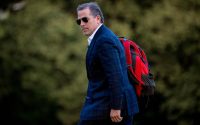Threat specialist Patrick Prince explains how to stop mass shootings
A renowned threat assessment consultant dubbed the “grim reaper” for his proximity to some of the country’s most infamous tragedies says the battle to stop mass shooters can only be won by authorities identifying them and intervening at the first warning signs.
“Many things we do are meaningless,” said Patrick Prince, the University of South California’s chief threat assessment officer, in an interview with the Nashville Tennessean.
“We should be asking, ‘How can we prevent them?’”
Prince, who has worked as a consultant for four decades, pointed to FBI statistics from 2018, which said 56% of mass shooters showed warning signs two years before carrying out the act, according to the report.
A staggering 98% of people who knew people who go on to be shooters sensed something was amiss, he said.
There were 647 mass shootings, or those involving four or more victims, in 2022 alone, according to the Gun Violence Archive and there have been 361 mass shootings in the US so far this year.


The warning signs, referred to as “leakage,” involve the shooter revealing “clues to a third-party about feelings, thoughts, fantasies, attitudes or intentions that may signal intent to commit a violent act,” the FBI said.
“Something has affected their identity, their feeling of self worth,” he told the Tennessean. “People don’t want to come in and shoot up the place,” he said. “Let’s deal with them when they’re fantasizing about the shooting.”
As part of their 2018 research the FBI released a study examining the behaviors of the gunmen prior to carrying out their acts in 160 active shooter cases in the US from 2000 to 2013.
“On average,” the report found, “each active shooter displayed four to five concerning behaviors over time that were observable to others around the shooter. The most frequently occurring concerning behaviors were related to the active shooter’s mental health, problematic interpersonal interactions, and leakage of violent intent.”
Prince said shooters often “ruminate over perceived injustices” and apply “a name and face to a grievance,” something he called “Hostile Attributional Violence,” the report said.



Prince became known as the “grim reaper” as he delved into trauma response and consulting early in his career.
He stressed more needs be done before a shooter becomes committed to carrying out deadly acts. He also claimed trying to prevent killings after the person has made up their mind is often ineffective.
Prince added he felt “more guns equals more death,” according to The Tennessean, and adding more security and protection measures or arming more people, such as teachers, were not the answer.


Prince cited The Covenant School shooting in March where Audrey Hale carried out a killing spree at her old school in the same state where he lives.
At least one person on the property was armed at the time. But Hale nonetheless killed six people – including three nine-year-old students – in 14 minutes before police gunned her down.
Prince has weighed in on over 3,500 violence-or threat-related incidents at schools, private institutions and government facilities.
He’s been called in to create reports assessing various shootings including the 2001 Santana High School shooting in Santee, California, where 17 people were wounded; the November 2019 mass shooting at a Saugus, California, high school, and the 2015 on-air shooting deaths of two new station employees at Roanoke, Virginia’s WDBJ station.


